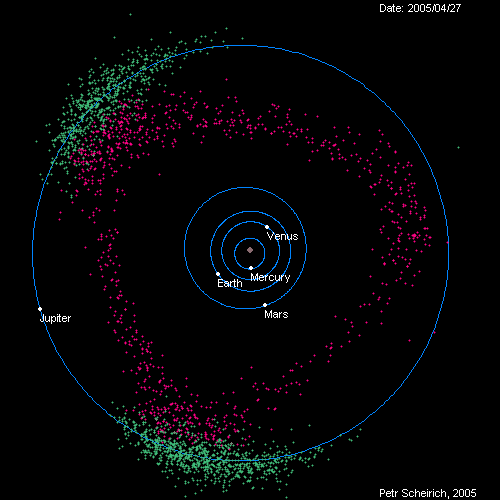A Cosmic Blossom

A cosmic blossom
IC 5148 is a beautiful planetary nebula located some 3000 light-years away in the constellation of Grus (The Crane). The nebula has a diameter of a couple of light-years, and it is still growing at over 50 kilometres per second — one of the fastest expanding planetary nebulae known. The term “planetary nebula” arose in the 19th century, when the first observations of such objects — through the small telescopes available at the time — looked somewhat like giant planets. Although the name stuck, it represents the expanding shell of gas ejected from old red giant stars late in their lives.
And now this one resembles a lovely blossom with layered petals.
Credit: European Southern Observatory
More Posts from Xnzda and Others

Solarbeat
This is magical. whitevinyldesign.com/solarbeat
via wired
Because every planet has its own orbital period, “it ends up generating this unending, interesting pattern,” Twyman says. For example, Mercury, which has an orbit of 88 Earth days, is the backbeat to the sound, while Pluto, which takes approximately 248 years to orbit the sun, rarely makes an appearance in the music. “It really lends itself to generating ambient music,” he says. You can tweak the speed of orbit, slowing it down to make a soothing tinkle of a child’s mobile or speeding it up to orchestrate a chaotic planetary choir. New features allow you to add sound effects like echo, flutter and bass, and you can choose from eight different chords to personalize the sound. READ MORE

Aurora and Manicouagan Crater from the Space Station : How many of these can you find in today’s featured photograph: an aurora, airglow, one of the oldest impact craters on the Earth, snow and ice, stars, city lights, and part of the International Space Station? Most of these can be identified by their distinctive colors. The aurora here appears green at the bottom, red at the top, and is visible across the left of image. Airglow appears orange and can be seen hovering over the curve of the Earth. The circular Manicouagan Crater in Canada, about 100 kilometers across and 200 million years old, is visible toward the lower right and is covered in white snow and ice. Stars, light in color, dot the dark background of space. City lights appear a bright yellow and dot the landscape. Finally, across the top, part of the International Space Station (ISS) appears mostly tan. The featured image was taken from the ISS in 2012. via NASA

At the Heart of Orion.

The orbit of Jupiter protects the Earth from asteroids.

The Pinwheel Galaxy - this giant disk of stars, dust and gas is 170,000 light-years across; nearly twice the diameter of the Milky Way. It is estimated to contain at least one trillion stars, approximately 100 billion of which could be like our Sun in terms of temperature and lifetime [6000x4690]
js

The Carina Nebula - A Birthplace Of Stars
The Carina Nebula lies at an estimated distance of 6,500 to 10,000 light years away from Earth in the constellation Carina. This nebula is one of the most well studied in astrophysics and has a high rate of star formation. The star-burst in the Carina region started around three million years ago when the nebula’s first generation of newborn stars condensed and ignited in the middle of a huge cloud of cold molecular hydrogen. Radiation from these stars carved out an expanding bubble of hot gas. The island-like clumps of dark clouds scattered across the nebula are nodules of dust and gas that are resisting being eaten away by photons (particles of light) that are ionizing the surrounding gas (giving it an electrical charge).
Credit: NASA/Hubble

M51: The Whirlpool Galaxy
Credit: NASA, ESA, S. Beckwith (STScI), and the Hubble Heritage Team (STScI/AURA)

Atmospheric Jellyfish are described as jellyfish-like creature seen floating in the Earth’s atmosphere. Atmospheric Jellyfish are said to look like normal jellyfish except they are floating in the sky much like a cloud and are seen mostly around military bases. Skeptics believe that the Atmospheric Jellyfish could be misidentified clouds or weather balloons however believers hold true to the idea and remember the time that NASA sent 60,000 jellyfish into space during their From Undersea to Outer Space experiment.
-
 tresfoufou liked this · 1 year ago
tresfoufou liked this · 1 year ago -
 ivebeentotheforest liked this · 2 years ago
ivebeentotheforest liked this · 2 years ago -
 thomasbrisenio liked this · 4 years ago
thomasbrisenio liked this · 4 years ago -
 xnzda reblogged this · 6 years ago
xnzda reblogged this · 6 years ago -
 madnessundercover reblogged this · 6 years ago
madnessundercover reblogged this · 6 years ago -
 strawberryhoneycomb reblogged this · 7 years ago
strawberryhoneycomb reblogged this · 7 years ago -
 wowarkhax-blog liked this · 7 years ago
wowarkhax-blog liked this · 7 years ago -
 gizmodeus liked this · 8 years ago
gizmodeus liked this · 8 years ago -
 c0smicdrift3r liked this · 8 years ago
c0smicdrift3r liked this · 8 years ago -
 housetakenover liked this · 8 years ago
housetakenover liked this · 8 years ago -
 lutefisk-kingdom liked this · 8 years ago
lutefisk-kingdom liked this · 8 years ago -
 1984chan reblogged this · 8 years ago
1984chan reblogged this · 8 years ago -
 brettejensen45 liked this · 8 years ago
brettejensen45 liked this · 8 years ago -
 baqaida liked this · 8 years ago
baqaida liked this · 8 years ago -
 hipsth liked this · 8 years ago
hipsth liked this · 8 years ago -
 minimizemeforever-blog liked this · 8 years ago
minimizemeforever-blog liked this · 8 years ago -
 submersion liked this · 8 years ago
submersion liked this · 8 years ago -
 nicolianeko liked this · 8 years ago
nicolianeko liked this · 8 years ago -
 zinish reblogged this · 8 years ago
zinish reblogged this · 8 years ago -
 zinish liked this · 8 years ago
zinish liked this · 8 years ago -
 myspiritualdreams liked this · 8 years ago
myspiritualdreams liked this · 8 years ago -
 myspiritualdreams reblogged this · 8 years ago
myspiritualdreams reblogged this · 8 years ago -
 anaisswatterson reblogged this · 8 years ago
anaisswatterson reblogged this · 8 years ago -
 strawberry-nectar-blog reblogged this · 8 years ago
strawberry-nectar-blog reblogged this · 8 years ago -
 dewanagariari reblogged this · 8 years ago
dewanagariari reblogged this · 8 years ago -
 satkaz reblogged this · 8 years ago
satkaz reblogged this · 8 years ago -
 desmerveilles reblogged this · 8 years ago
desmerveilles reblogged this · 8 years ago -
 thingsfreelygiven reblogged this · 8 years ago
thingsfreelygiven reblogged this · 8 years ago -
 thingsfreelygiven liked this · 8 years ago
thingsfreelygiven liked this · 8 years ago -
 jenyfly reblogged this · 8 years ago
jenyfly reblogged this · 8 years ago -
 secretporcupine reblogged this · 8 years ago
secretporcupine reblogged this · 8 years ago -
 seao-fstars liked this · 8 years ago
seao-fstars liked this · 8 years ago -
 susiejacobo liked this · 8 years ago
susiejacobo liked this · 8 years ago

